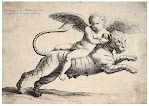
I watched a European starling hop around a supermarket parking lot today. His iridescent feathers glistened in the sun and he was puffed up a little from the cold. He was about as pretty as it is possible for a starling to be. I don't think any passerine has a more ungainly walk than a European starling, and the relative lack of a tail is a pretty serious fashion handicap, but when they're standing still, giving a full frontal view like the guy in the photo, they can be handsome birds.
Looks aren't everything, though, and I don't think there's any bird Americans hate more than starlings. My grandmother, who was not generally prone to violence, used to go after them with a pellet pistol. We'd be sitting in the kitchen having breakfast, and Granny would spy them through the window. She'd jump out of her chair, a woman on a mission. Starlings at my feeder! she'd say with fury, then she'd commence shooting at them out the back door.
I've never known anybody else who took up arms against the starlings, but a lot of serious birders do advocate killing them, which is perfectly legal. Along with the house sparrows, they're officially designated as alien nuisances. Homeowners are free to kill them and/or destroy their eggs and nests. If you've ever kept feeders or tried to draw bluebirds to your yard you can understand why. Gangs of starlings will bully every other species away from a feeder and then gorge like a busload of tourists at a buffet. They are just as greedy when it comes to housing. They're brutal about driving other cavity-nesters away from desirable homes. I won't inflict a link on you, but there are plenty of sites online with pictures of what starlings and house sparrows will do to bluebirds they wish to evict. It's not pretty.
Oddly for such aggressive nesters, they are neglectful parents. It's always a little sad to see fledgling starlings begging for food from oblivious adults, while the woodpeckers and bluebirds are feeding their offspring so lovingly. Starlings nurture their young very briefly and then junior is on his own. A lot of the babies don't make it, but most females lay a clutch at least twice in a season, so the infant mortality rate is clearly not a problem.
Even though there have been times I've felt like getting a pellet gun of my own, I don't think I could ever kill a starling. There's something tragic about them. They're so awkward and friendless. They didn't ask to be brought here, after all. They can't help being so freaking adaptable. It's ironic that we love least the creatures who are most able to thrive in the face of our rapacious ways.
Looking at that bird in the parking lot today, I thought about another starling encounter I had years ago. It was an unusually chilly late spring night, and as I walked back to my car after paying for my gas, I saw a pair of chicks huddled together on the cold concrete. They seemed to have just left the nest, and the glare of the station lights probably confused them. One of the chicks looked like a goner, but the other was pretty vigorous. If no one ran over him--a big if--he might survive. It made about as much sense as cheering on fire ants or Formosan termites, but I couldn't help rooting for him: You hang in there, little guy. I hope he made it.
European Starling page at the Cornell Lab of Ornithology
Photo by Mark Skipper from Wikimedia Commons




